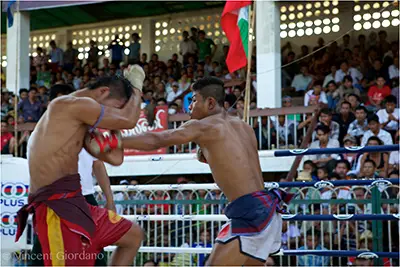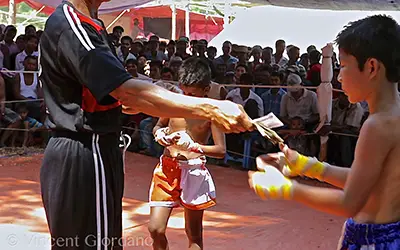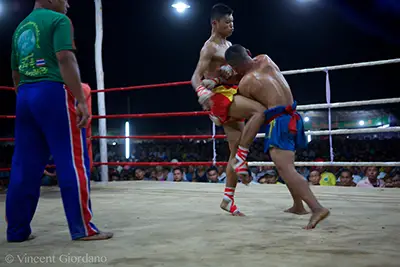Guest post by Vincent Giordano
Fighting sports and martial tradition have always been an integral part of Burmese life. In ancient times, some fighting sports were preparations for war and survival. Others served as a rite of passage for boys transitioning into adulthood. After five decades of harsh military rule and endless violence, pseudo-democratic reforms were finally introduced to Myanmar in 2011. During this dark period, many Burmese clung tightly to their rich cultural heritage as a way to blot out the deep oppression that clouded their daily lives. Lethwei – the Burmese art of bare-knuckle fighting – is one of those age-old traditions that has been quietly maintained in the rural villages throughout Myanmar for centuries.
The Burmese calendar year is lunar and enlivened by a continual array of festivals. The best-known of these is Thingyan, a four-day celebration culminating on New Year’s Day, and which is closely followed by a series of local pagoda festivals. Lethwei matches are a central component of these festive events. The matches take on a totally different cultural importance and feel than those of the bigger commercial Lethwei shows and spectacles held in major cities like Yangon and Mandalay. The fights are celebratory and the crowds show up to cheer the local fighters. There is a tremendous joy, camaraderie and fighting spirit displayed throughout the festival. In the villages, martial tradition was an important component of the spiritual and physical growth of each young man, and during the lively festival fights he could demonstrate his fighting prowess.
Boys as young as 10 years old would begin a painful initiation process by tattooing their upper thighs. The tattoos would be proudly displayed at the start of a match, when a fighter would slap at them repeatedly in the belief that it would ignite their sacred powers and protect him during the match. A young man devoid of tattoos would be considered a coward and unlikely to land a fight in any of the matches. Today this aspect of the tradition has changed, but we still see fathers bringing their young children to engage in friendly Lethwei matches to test their mettle and courage.
The festival and pagoda fights adhere to time-honored traditions. The fighters wear no gloves. Head butts, throws, knees, elbows, punches and kicks are allowed. The fights are fought in several ways, the most traditional of which is in a circle with the crowd surrounding the fighters. Two referees maintain control of the fighting arena at all times. The matches are accompanied by drumming and music. This convention is much the same throughout Thailand, Cambodia and Laos.
The fights begin with an opening blessing ceremony followed by presentations of Lethwei Yei. The Yei is a short, explosive display of skill and courage aimed at the opponent and a sign to the audience that the fighter is ready and able to fight. The Burmese version is different from the opening fighter dances of Cambodia, Thailand and Laos. The ring is then filled with potential fighters who hope to be paired and allowed to fight. They generally return day after day. Some might even fight multiple times in the week-long fight festivals.
One distinguishing feature of the Thingyan and pagoda fights is that they are more about the celebration than blood lust. The refs want a spirited bout and often – especially with children – keep the bouts short and lively. The crowd and promoters often reward the more spectacular and gutsy fighters with money for their spirited performance.
In the Kayin State, the matches are generally held at night as part of a night bazaar. The bazaar is crammed with stalls that sell food and drink and entertainment the whole family can take part in.
Lethwei is growing in the commercial sector, sponsored by rich businessmen and government agencies looking to dominate and control it as a commodity. However, the rural pagoda festivals remain untouched by commercial interests and control.
“Lethwei has survived in the rural communities for as long as the sport has been fought and practiced,” explains Saya Win Zin Oo, head of the Yangon-based Thut Ti Lethwei camp, “I believe it will always remain that way. Lethwei can have all the organizations and controlling factors it wants, but traditional Lethwei lives and breathes in the rural areas that honor and maintain it as an ancient tradition that is part of life itself.”
Lethwei is one of the world’s last great bare-knuckle traditions. Most people today see the large-scale televised Lethwei matches held in places like Yangon. But the true heart and soul of Lethwei remains in rural villages that have kept the art alive through decades of isolation and repression enforced by a brutal and xenophobic military dictatorship. It is a joyous and entertaining spectacle that is best witnessed live with the always-enthusiastic crowds.
Visit the Born Warriors website, their Facebook Fan Page, and YouTube channel.
Watch the trailer for Born Warriors Redux:
Story and photos © 2015 Vincent Giordano. All rights reserved.





It is true that we Myanmar love our traditional boxing. And there are other forms of traditional martial arts too. But this Myanmar boxing is fascinated by people young and old alike. Only the brave ones want to play Myanmar boxing because it can show their bravery and prowess. There is still a succession of Myanmar traditional boxing. The current successful and.popular boxer is ”Lone Chaw” whom we can really proud of.
This is a wonderful article. Vincent Giordano has traveled and trained extensively throughout his life through most of Southeast Asia and India documenting and surviving these ancient traditions. His forthcoming documentary should be an exemplary example of his work within Myanmar. He has covered quite extensively Thaing, Bando and Naban as well as healing traditions for his other projects as the poster mentions the other martial arts of Myanmar. So hopefully we will see that in the near future as well.